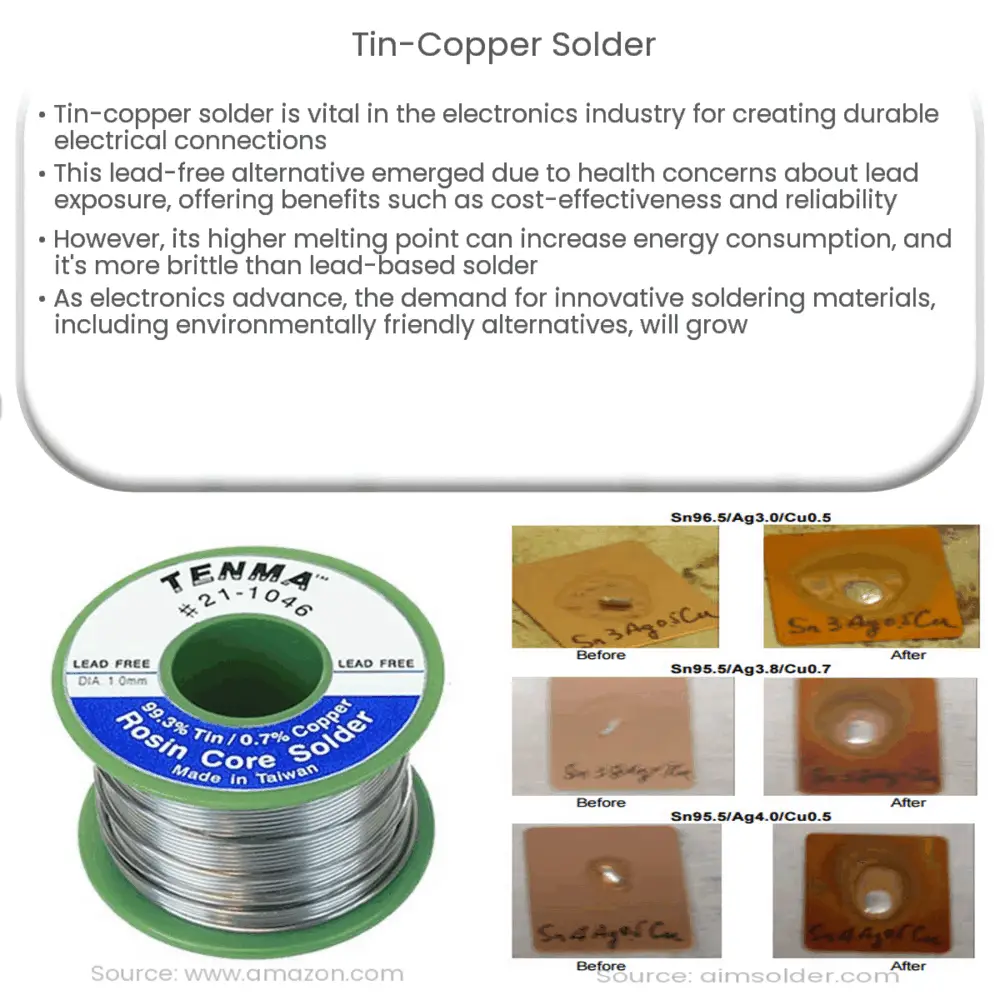Tin-copper solder is a vital, lead-free alloy in electronics, offering reliable connections, cost-effectiveness, and corrosion resistance.

Tin-Copper Solder: An Essential Alloy in Electronics
Introduction
Tin-copper solder is an indispensable alloy in the electronics industry, used for creating reliable and durable connections between electrical components. This article will provide an overview of tin-copper solder, its history, properties, and applications, as well as its role in lead-free soldering alternatives. In the second part, we will discuss the advantages and disadvantages of tin-copper solder, health and environmental concerns, and future trends in soldering technology.
History of Tin-Copper Solder
Soldering dates back to ancient civilizations, where it was used for joining metals and creating decorative objects. Early soldering techniques used lead-based alloys, but over time, concerns about the negative health effects of lead exposure led to the development of lead-free alternatives. Tin-copper solder emerged as a popular choice due to its suitable melting point, mechanical strength, and relatively low cost. As electronics manufacturing grew, so did the demand for tin-copper solder, making it an essential material in modern technology.
Composition and Properties
Tin-copper solder is a binary alloy, composed primarily of tin (Sn) and copper (Cu). The most common composition is 99.3% tin and 0.7% copper, often referred to as Sn99.3Cu0.7. Other compositions with varying tin-to-copper ratios are also used, depending on specific requirements. Key properties of tin-copper solder include:
- Melting point: The melting point of Sn99.3Cu0.7 is around 227°C (441°F), which is higher than traditional lead-based solder but still within the range suitable for electronics applications.
- Mechanical strength: Tin-copper solder provides good mechanical strength, ensuring durable connections between electrical components.
- Corrosion resistance: The alloy is resistant to corrosion, an essential property for maintaining long-term reliability in electronic devices.
- Wettability: Tin-copper solder has good wettability, allowing it to flow and spread easily on metal surfaces, resulting in strong and even joints.
Applications
Tin-copper solder is widely used in a variety of electronics applications, including:
- Printed circuit boards (PCBs): Solder is used to attach electronic components to PCBs, forming strong and reliable electrical connections.
- Wire-to-wire and wire-to-terminal connections: Soldering is employed to create stable and durable connections between wires and terminals in various electronic devices.
- Surface-mount technology (SMT): Tin-copper solder is used in SMT, a method for attaching small components to PCBs, which is common in modern electronics manufacturing.
- Automotive electronics: Solder is used in various automotive electronic systems, such as sensors, control modules, and entertainment systems.
Continue to Part 2 for a discussion of the advantages and disadvantages of tin-copper solder, health and environmental concerns, and future trends in soldering technology.
Tin-Copper Solder: Advantages and Disadvantages
In this section, we will explore the advantages and disadvantages of tin-copper solder, taking into consideration its performance, cost, and environmental impact.
Advantages
- Lead-free: Tin-copper solder is a lead-free alternative, eliminating the health and environmental concerns associated with lead-based solder.
- Cost-effective: The alloy is relatively inexpensive compared to other lead-free alternatives, making it a popular choice for electronics manufacturers.
- Reliability: Due to its mechanical strength and corrosion resistance, tin-copper solder provides long-lasting connections in electronic devices.
- Industry adoption: Tin-copper solder is widely accepted in the electronics industry, with many manufacturers adopting it as a standard material for soldering applications.
Disadvantages
- Higher melting point: Tin-copper solder has a higher melting point than traditional lead-based solder, which can lead to increased energy consumption and the potential for thermal damage to components during soldering.
- Brittleness: The alloy is more brittle than lead-based solder, making it more susceptible to cracking under mechanical stress or thermal cycling.
- Grainy structure: Tin-copper solder can exhibit a grainy structure, which may result in weaker joints compared to other lead-free alternatives.
Health and Environmental Concerns
One of the primary drivers behind the development of tin-copper solder was the health and environmental concerns associated with lead-based solder. Lead exposure can lead to neurological damage, especially in children, and is also harmful to the environment. Tin-copper solder eliminates these concerns by providing a lead-free alternative that meets performance requirements for electronics manufacturing. As a result, many countries have adopted regulations to limit or eliminate the use of lead in electronic products, further promoting the use of tin-copper solder.
Future Trends in Soldering Technology
As the electronics industry continues to evolve, so will the demand for improved soldering materials. Future trends in soldering technology may include:
- Lower melting point alloys: Research is ongoing to develop lead-free solder alloys with lower melting points, reducing energy consumption and the risk of thermal damage during soldering.
- Nano-enhanced solders: The addition of nanoparticles to solder alloys can improve properties such as mechanical strength, thermal conductivity, and fatigue resistance, leading to more reliable and efficient connections.
- Environmentally friendly alternatives: As environmental regulations become more stringent, there is increasing interest in developing solder materials with a reduced environmental impact, including the use of recycled or biodegradable materials.
In conclusion, tin-copper solder is an essential alloy in the electronics industry, providing a lead-free alternative that meets the demands of modern manufacturing. While it has some disadvantages, its widespread adoption and ongoing research in soldering technology ensure that tin-copper solder will remain a critical material in the ever-evolving world of electronics.

